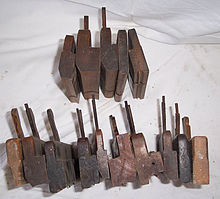- Moulding plane
-
In woodworking, a moulding plane (molding plane in US spelling) is a specialised plane used for making the complex shapes found in wooden mouldings.
Traditionally, moulding planes were blocks of wear resistant hardwood, often Beech or Maple, which were worked to the shape of the intended moulding. The blade, or iron was likewise formed to the intended moulding profile and secured in the body of the plane with a wooden wedge. A traditional cabinetmakers shop might have many, perhaps hundreds, of moulding planes for the full range of work to be performed. The late nineteenth century brought modern types which were all metal affairs such as the American Stanley No. 55 Universal Plane[1] and the English Record No. 405 Multi-Plane with a wide variety of interchangeable cutters, integral fences, and "knickers", small cutting edges which score the grain fibers when working across the board.[2]
Large crown mouldings required planes of six or more inches in width which demanded great strength to push and often had additional peg handles on the sides, allowing the craftsmans' apprentice or other worker to pull the plane ahead of the Master who guided it.[3]
While generally considered outdated, a modern furniture shop doing reproduction or restoration work might keep a collection of moulding planes to match original work, or to build in an authentic manner.
The earliest known record of a moulding plane is a moulding plane iron of Roman origin unearthed in Cologne, Germany.[3]
In modern industry, the work of the moulding plane has been taken up by the electrically powered spindle moulder or wood shaper. On a smaller scale, the hand-held or table mounted electric router allows the use of interchangeable router bits of a wide variety of profiles and is readily available to the small business or home craftsperson.
Notes

This article about joinery, woodworking joints, carpentry or woodworking is a stub. You can help Wikipedia by expanding it.


